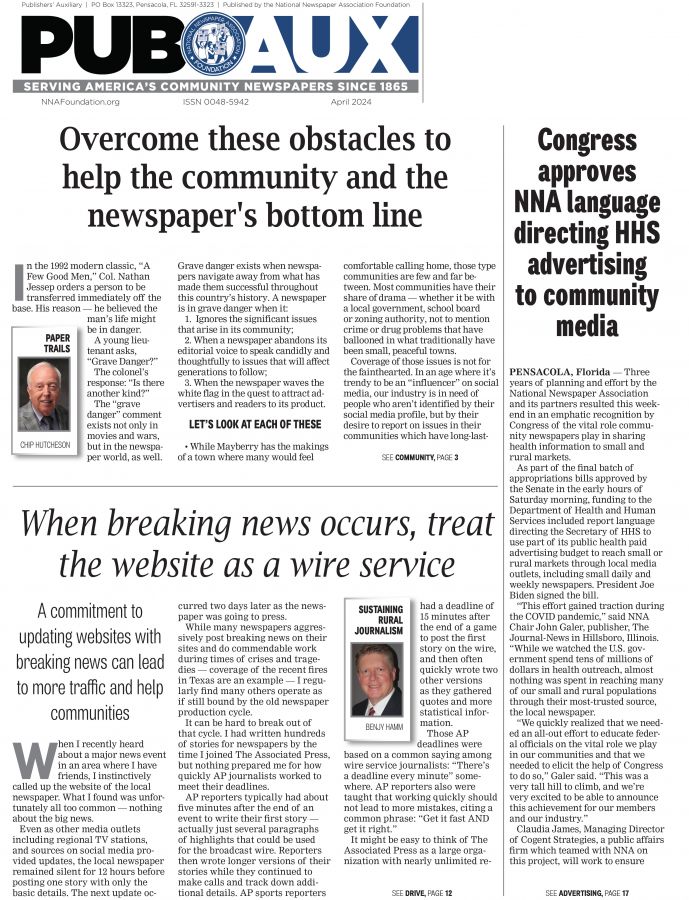NNA gears up for 2017 postal fight
Jan 5, 2017
By Tonda F. Rush
NNA | Director of Public Policy
The National Newspaper Association will participate throughout 2017 in a major new review of postal rates conducted by the Postal Regulatory Commission.
When the Postal Accountability and Enhancement Act was passed by Congress in 2006, it set an inflation-based cap on postage increases. The cap put an end to the experiences of publishers from 1970 to 2001 of Periodicals and Standard mail rates ballooning every three years when the U.S. Postal Service was permitted to charge whatever it needed to cover its costs. Newspapers experienced postage increases in the double-digit range for many years.
PAEA also charged the PRC with examining the rate cap at the end of a decade, and to decide whether that rate system met the requirements of the law. That rate review began Dec. 20.
Since PAEA, the Postal Service has been bathed in red ink. The causes of financial loss are multiple: the Great Recession, the diversion of First-Class Mail to digital avenues, continued above-inflation labor contract increases and a requirement imposed by Congress for USPS to prepay its retiree health benefits, which imposed roughly a $5 billion liability upon the USPS each year. The combination of forces, along with rates that cannot rise above inflation, has sundered service, as the postmasters general of the modern era have closed facilities in an effort to stay afloat.
Now the PRC is to decide whether the rate cap can continue.
The proceeding will occur in two phases. First, the PRC will decide whether the present system works. That determination is scheduled for late spring. Second, it will decide what system could take its place.
The colloquy will be conducted on paper at the outset, with first comments due March 20, 2017. Assuming the PRC decides the present system is flawed, a flurry of succeeding events is expected, from appeals to the U.S. courts over the scope of PRC authority, to a parade of economists floating their favorite theories. By the end of 2018, newspapers will know the PRC’s will. Whether the courts and Congress will permit that will to be exercised is uncertain.
For 2017, postage budgets are unlikely to see much effect beyond the usual inflation-based adjustments. See Max Heath’s Postal Tips column on Page 16 of this issue and in the November issue for details. If Congress passes a postal reform bill, having failed to cross the finish line with a bill NNA supported in 2016, the possibility of a moderate rate adjustment during calendar year 2017 remains. NNA had agreed to a 2.15 percent increase provided guarantees of improved service were included in the bill. However, early passage of any legislation in the 115th Congress is remote.
By 2018, postage budgets may encounter a whole new world.
“I see this case as the biggest challenge NNA has faced from the PRC for a decade,” NNA Postal Committee Chair Max Heath said. “Thanks to NNA’s work in getting PAEA passed, we have enjoyed a decade of welcome moderation after the seesawing rates of the two decades previous to 2006. Given the recession and the state of the industry, that moderation kept newspapers in the mail, despite dismal service in many areas. Now, the threat exists that we will see no great improvement in service, but we also will be paying much more.”
“We have pledged to our members that we will defend the interests of community newspapers in this case,” said NNA president Matthew Paxton IV, publisher of The News-Gazette in Lexington, VA. “NNA met with several of the PRC members and staff in November to lay out our principal concern: that the decline in service quality in small towns has passed largely unnoticed because USPS does not fairly measure mail service outside metropolitan areas. The PRC was interested in NNA’s efforts to improve both the measurement and the actual service. Although we will be among dozens of participants in this case, I believe we will be fairly heard.”







